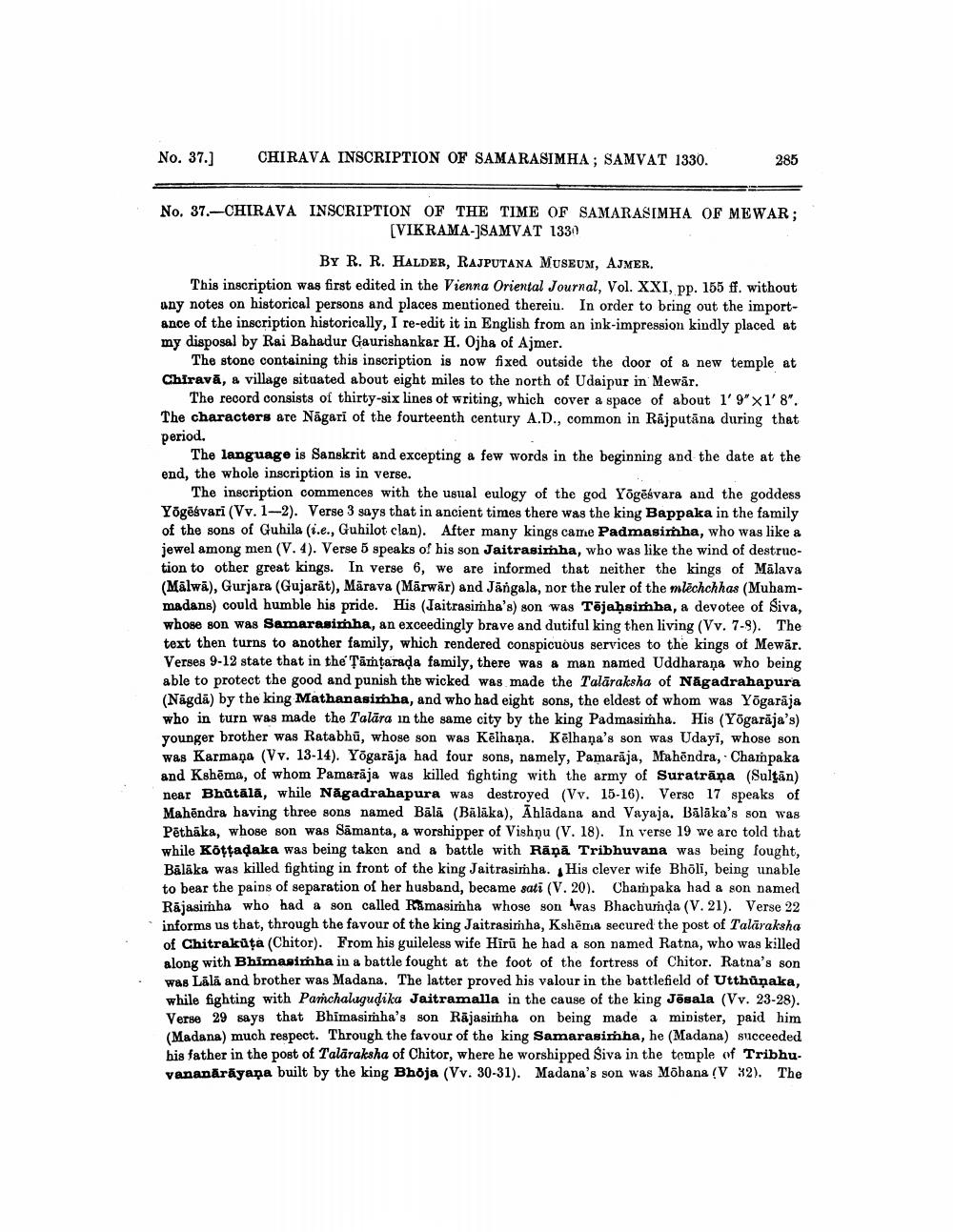________________
No. 37.]
CHIRAVA INSCRIPTION OF SAMARASIMHA ; SAMVAT 1330.
285
No. 37.-CHIRAVA INSCRIPTION OF THE TIME OF SAMARASIMHA OF MEWAR;
(VIKRAMA-SAMVAT 1330
BY R. R. HALDER, RAJPUTANA MUSEUM, AJMER. This inscription was first edited in the Vienna Oriental Journal, Vol. XXI, pp. 155 ff. without any notes on historical persons and places mentioned thereiu. In order to bring out the importance of the inscription historically, I re-edit it in English from an ink-impression kindly placed at my disposal by Rai Bahadur Gaurishankar H. Ojha of Ajmer.
The stone containing this inscription is now fixed outside the door of a new temple at Chiravā, a village situated about eight miles to the north of Udaipur in Mewār.
The record consists of thirty-six lines of writing, which cover a space of about 1' 9"x1'8". The characters are Nāgari of the fourteenth century A.D., common in Rājputāna during that period.
The language is Sanskrit and excepting a few words in the beginning and the date at the end, the whole inscription is in verse.
The inscription commences with the usual eulogy of the god Yögësvara and the goddess Yögēgvari (Vv. 1-2). Verse 3 says that in ancient times there was the king Bappaka in the family of the sons of Guhila (i.e., Guhilot clan). After many kings came Padmasimha, who was like a jewel among men (V. 4). Verse 5 speaks of his son Jaitrasimha, who was like the wind of destruction to other great kings. In verse 6, we are informed that neither the kings of Mālava (Mālwā), Gurjara (Gujarat), Mārava (Mārwar) and Jāngala, nor the ruler of the mlēchchhas (Muhammadans) could humble his pride. His (Jaitrasimha's) son was Tējaħsimha, a devotee of Siva, whose son was Samarasimha, an exceedingly brave and dutiful king then living (Vv. 7-9). The text then turns to another family, which rendered conspicuous services to the kings of Mewär. Verses 9-12 state that in the Tāmțarada family, there was a man named Uddharana who being able to protect the good and punish the wicked was made the Talāraksha of Nāgadrahapura (Nägda) by the king Mathanasimha, and who had eight sons, the eldest of whom was Yogarāja who in turn was made the Talāra in the same city by the king Padmasimha. His (Yögarāja's) younger brother was Ratabhū, whose son was Kēlhaņa. Kēlhana's son was Udayi, whose son was Karmaņa (Vv. 13-14). Yogaraja had four sons, namely, Pamarāja, Mahendra, Champaka and Kshēma, of whom Pamarāja was killed fighting with the army of Suratrāņa (Sultan) near Bhūtālā, while Nāgadrahapura was destroyed (Vv. 15-16). Verse 17 speaks of Mahēndra having three sons named Bālā (Bālāka), Ahlādana and Vayaja. Bālāka's son was Pēthāka, whose son was Samanta, a worshipper of Vishnu (V. 18). In verse 19 we are told that while Köţtadaka was being taken and a battle with Rāņā Tribhuvana was being fought, Bälāka was killed fighting in front of the king Jaitrasimha. His clever wife Bhõli, being unable to bear the pains of separation of her husband, became sati (V. 20). Champaka had a son named Rajasimha who had a son called Ramasimha whose son was Bhachumda (V. 21). Verse 22 informs us that, through the favour of the king Jaitrasimha, Kshēma secured the post of Talāraksha of Chitrakūța (Chitor). From his guileless wife Hirū he had a son named Ratna, who was killed along with Bhimasimha in a battle fought at the foot of the fortress of Chitor. Ratna's son was Lala and brother was Madana. The latter proved his valour in the battlefield of Utthùņaka, while fighting with Parchalugudika Jaitramalla in the cause of the king Jēsala (Vv. 23-28). Verse 29 says that Bhimasimha's son Rājasimha on being made a minister, paid him (Madana) much respect. Through the favour of the king Samarasimha, he (Madana) succeeded his father in the post of Talāraksha of Chitor, where he worshipped Siva in the temple of Tribhuvananārāyana built by the king Bhoja (Vv. 30-31). Madana's son was Möhana (V x2). The




